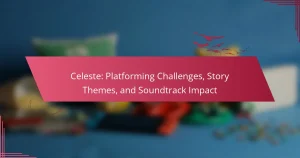Spiritfarer offers a unique blend of emotional storytelling, resource management, and artistic design. Players navigate themes of loss and connection while managing materials to support spirits on their journey. The game’s hand-drawn visuals and immersive soundtrack enhance the overall atmosphere, making each interaction meaningful. This article explores the emotional journey, gameplay mechanics, and artistic elements that define Spiritfarer.
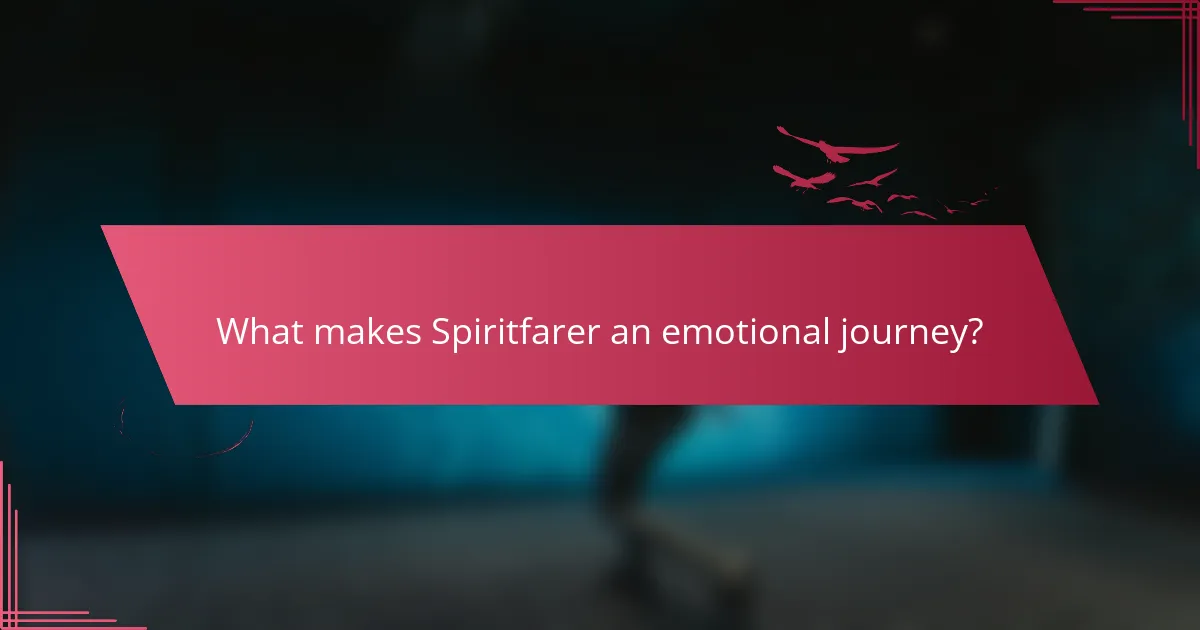
What makes Spiritfarer an emotional journey?
Spiritfarer is an emotional journey due to its themes of loss, connection, and acceptance. Players guide spirits to the afterlife, fostering deep relationships that evoke feelings of nostalgia and sorrow. The resource management aspect enhances gameplay by requiring players to balance tasks while engaging with the emotional narrative. Art design contributes significantly, featuring hand-drawn visuals and a soothing soundtrack that amplify the game’s atmosphere. This combination of storytelling, gameplay mechanics, and artistic expression creates a uniquely poignant experience.
How does character development enhance player connection?
Character development in Spiritfarer deepens player connection by fostering emotional engagement. Players form bonds with characters through their unique stories and struggles. This connection enhances the gameplay experience, making resource management and artistic design more impactful. The emotional journey encourages players to invest time and care into the characters’ fates, creating a sense of purpose and attachment. As a result, character development becomes a vital aspect of the overall narrative, enriching the player’s journey.
Why is grief a central theme in Spiritfarer?
Grief is central in Spiritfarer as it explores loss and acceptance through emotional storytelling. The game allows players to guide spirits to the afterlife, emphasizing the importance of closure. Each character represents unique attributes of grief, showcasing various coping mechanisms and emotional journeys. The artistic design enhances this theme, creating a poignant atmosphere that resonates with players.
Which narrative techniques create an immersive experience?
Narrative techniques that create an immersive experience in Spiritfarer include emotional storytelling, environmental storytelling, and character development. Emotional storytelling engages players by exploring themes of loss and acceptance, making the journey relatable. Environmental storytelling enhances immersion through beautifully crafted visuals that convey mood and atmosphere, inviting exploration. Character development allows players to form connections with spirits, deepening emotional investment in their stories. Each technique contributes to a rich, engaging experience that resonates with players.
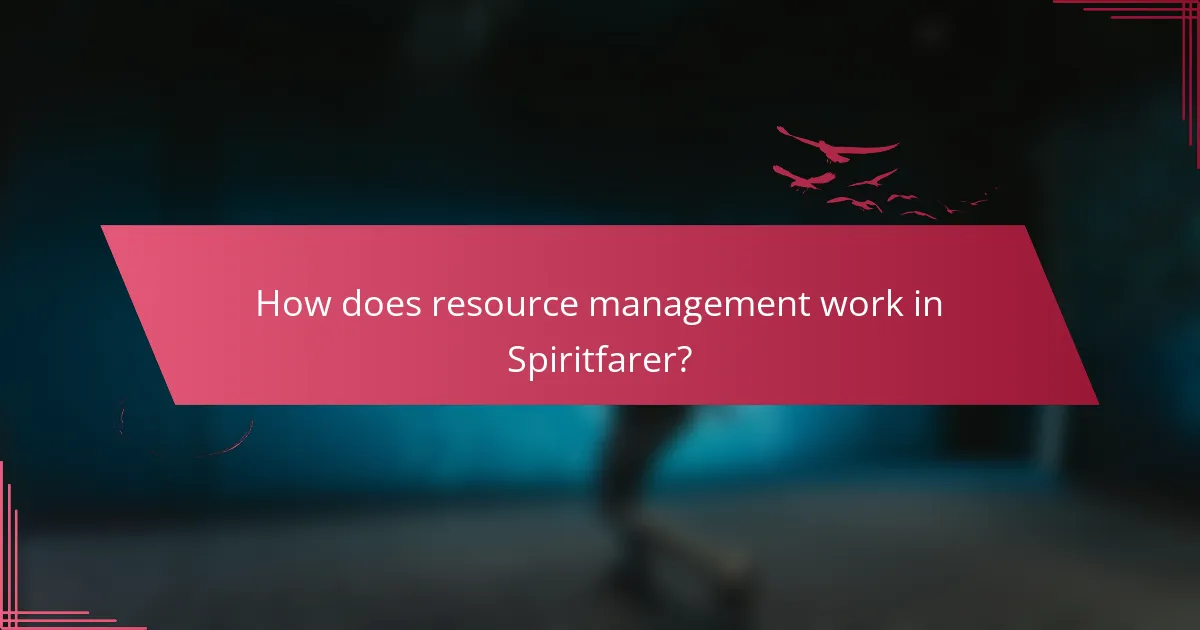
How does resource management work in Spiritfarer?
Resource management in Spiritfarer involves gathering, crafting, and upgrading materials to support spirits on their journey. Players collect resources like wood, metal, and food, which are essential for building and improving the ship. Crafting recipes allow players to transform raw materials into useful items, enhancing gameplay. Effective resource management is crucial for progressing through the emotional narrative, as it enables players to fulfill the needs of spirits and explore new areas. The unique attribute of this system lies in its integration with storytelling, making resource management not just a task but a meaningful part of the player’s emotional journey.
What types of resources can players gather?
Players can gather various resources in Spiritfarer, including wood, stone, and food items. These resources are essential for crafting, upgrading buildings, and cooking meals.
Wood serves as a primary building material, while stone is crucial for crafting tools and structures. Players can also collect minerals and plants, which are used for cooking and crafting. Additionally, players can gather special items from spirits, enriching the gameplay experience and emotional narrative.
Resource management is vital for progressing through the game, as each resource type has unique uses and benefits.
How do crafting and building mechanics influence gameplay?
Crafting and building mechanics in Spiritfarer enhance gameplay by fostering emotional connections and resource management. Players engage in crafting to create items that support their journey and the spirits they guide. This mechanic deepens interactions, as players must gather resources thoughtfully, reflecting the themes of care and companionship. Artistic design complements these mechanics, creating an immersive experience that emphasizes the emotional weight of each crafted item. The unique attribute of player choice in crafting influences the narrative, allowing for personalized experiences that resonate with individual players.
Which strategies optimize resource management efficiency?
Effective strategies to optimize resource management efficiency in Spiritfarer include prioritizing resource gathering, planning ship upgrades, and utilizing character interactions. By focusing on these aspects, players can enhance their emotional journey while managing resources effectively.
Resource gathering involves identifying and collecting essential materials, such as wood and ore, to craft items. Planning ship upgrades ensures that players allocate resources wisely for improvements that enhance travel and capacity. Character interactions provide opportunities to unlock unique abilities that streamline resource management.
These strategies collectively improve gameplay efficiency, allowing for a more immersive experience. Balancing emotional storytelling with resource management creates a rewarding journey.
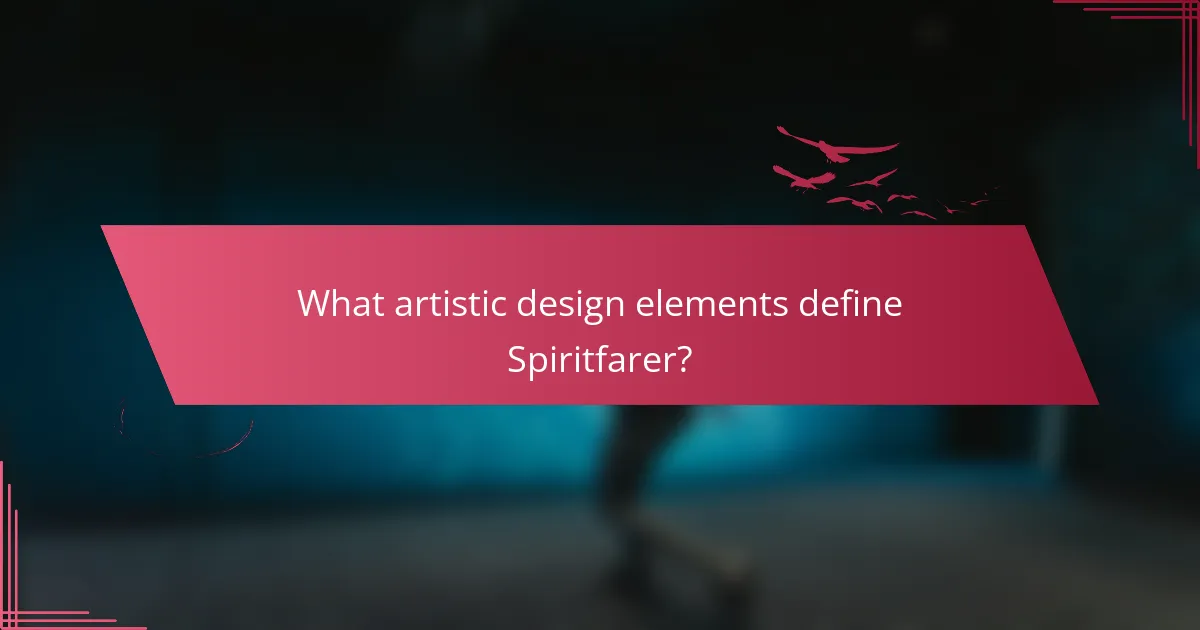
What artistic design elements define Spiritfarer?
Spiritfarer is defined by its hand-drawn art style, vibrant color palette, and emotional character designs. The game employs a unique blend of 2D visuals and layered backgrounds, creating a rich, immersive world. Each character embodies distinct attributes, reflecting their personal stories and emotional journeys. The use of light and shadow enhances the atmosphere, contributing to the overall theme of acceptance and farewell. The artistic design intricately supports the gameplay mechanics, emphasizing resource management while fostering emotional connections.
How does visual style contribute to the game’s atmosphere?
Visual style significantly enhances the atmosphere of “Spiritfarer” by creating an immersive emotional experience. The hand-drawn art and vibrant colors evoke a sense of warmth and nostalgia, reinforcing the game’s themes of loss and remembrance. Each character’s unique design reflects their personality and story, deepening player connections. The fluid animations contribute to a tranquil environment, inviting players to explore and engage with the world. Overall, the artistic design intertwines with gameplay, making the emotional journey more impactful.
What role does music play in enhancing emotional impact?
Music significantly enhances emotional impact in “Spiritfarer” by deepening the narrative experience. The game’s soundtrack evokes feelings of nostalgia, loss, and hope, aligning perfectly with its themes of farewell and acceptance. Each musical piece is carefully crafted to reflect the unique stories of characters, creating a profound connection between players and the emotional journey. The seamless integration of music with gameplay elements reinforces the overall atmosphere, making moments of resource management feel more meaningful and reflective.
Which design choices reflect cultural influences?
Design choices in Spiritfarer reflect cultural influences through visual aesthetics, character design, and narrative elements. The game showcases a blend of various cultural motifs, particularly those from Japanese and Western traditions.
The artistic design incorporates elements like traditional Japanese architecture, which enhances the immersive experience. Characters embody diverse cultural backgrounds, enriching the storytelling. The narrative draws from global folklore, emphasizing themes of loss and acceptance, resonating across cultures.
These design choices create a unique atmosphere that fosters emotional connections, highlighting the game’s core themes of journey and resource management.
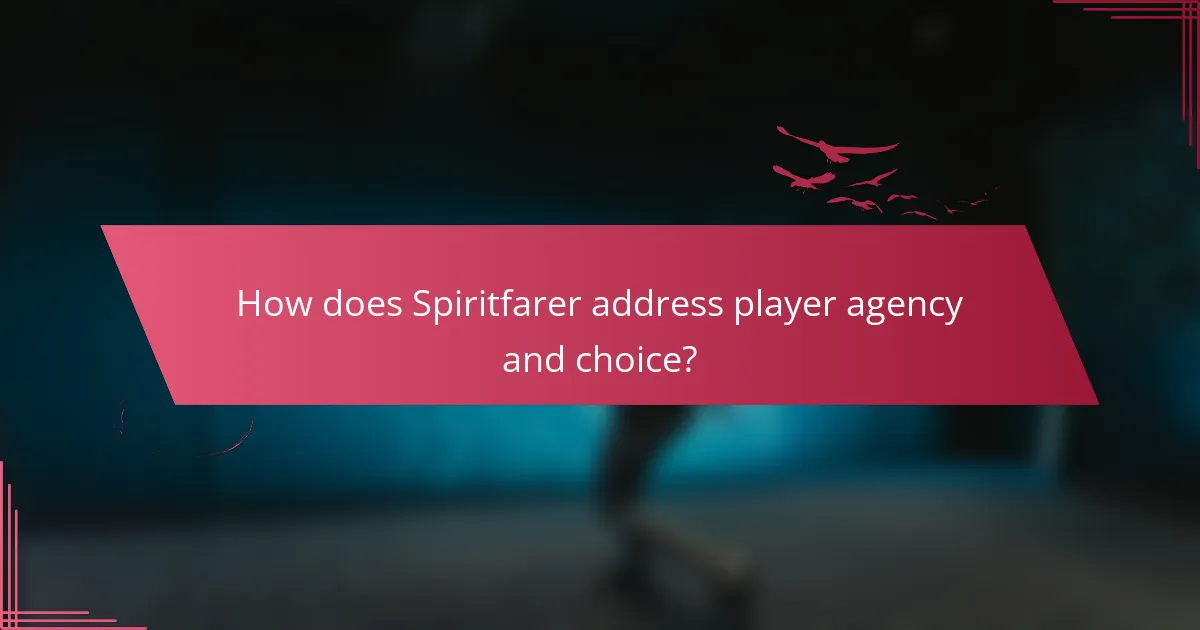
How does Spiritfarer address player agency and choice?
Spiritfarer empowers player agency through meaningful choices that shape the narrative and gameplay. Players decide how to interact with spirits, manage resources, and evolve their journey.
The game emphasizes emotional connections, requiring players to make decisions that impact relationships with characters. For instance, choosing how to fulfill a spirit’s final wish can lead to different outcomes, enhancing player investment.
Additionally, resource management is intricately linked to player choices. Players select which upgrades to pursue and how to allocate resources, influencing the game’s progression. This dynamic fosters a sense of ownership over the player’s experience.
Artistic design further enhances agency by providing a visually immersive world. The hand-drawn art style invites exploration, encouraging players to engage with the environment and make choices that resonate emotionally.
What are the implications of player decisions on the story?
Player decisions significantly shape the narrative in Spiritfarer, impacting character arcs and emotional outcomes. Choices determine which spirits to help, influencing their stories and the player’s journey. For instance, deciding whether to fulfill a spirit’s last request can lead to different endings, emphasizing themes of loss and acceptance. This dynamic interaction enriches the gameplay experience, making each player’s journey unique. The emotional weight of these decisions enhances the game’s artistic design, reinforcing its core message about companionship and letting go.
How do choices affect character relationships?
Choices significantly influence character relationships in Spiritfarer by shaping interactions and emotional depth. Each decision impacts bond development, leading to unique story arcs and character growth. Players experience varying outcomes based on choices, enhancing the emotional journey. The resource management aspect further complicates these relationships, as players must balance personal connections with practical needs, creating a dynamic narrative experience.

What challenges do players face while playing Spiritfarer?
Players face several challenges in Spiritfarer, including emotional connections with characters, resource management, and navigating the game’s artistic design. The emotional journey can be difficult as players must say goodbye to spirits they help. Resource management requires careful planning to gather materials and build upgrades, which can be time-consuming. Additionally, the artistic design, while beautiful, may create obstacles in navigation and understanding game mechanics. Balancing these elements adds depth to the gameplay experience.
Which common obstacles impact resource gathering?
Resource gathering in Spiritfarer faces obstacles like resource scarcity, time management challenges, and emotional strain from character interactions. These factors hinder effective gameplay and progression. Additionally, players may encounter unique obstacles such as specific character needs and rare materials that complicate resource collection. Understanding these challenges is crucial for improving resource management strategies.
How do emotional challenges manifest in gameplay?
Emotional challenges in gameplay manifest through narrative choices, character interactions, and resource management. In “Spiritfarer,” players confront themes of loss and acceptance, influencing emotional responses. The game’s artistic design enhances these experiences, creating a visually rich environment that mirrors emotional depth. Players navigate relationships with spirits, which embody personal struggles, fostering empathy and reflection. The emotional journey is integral to gameplay, making it a unique experience that resonates on multiple levels.
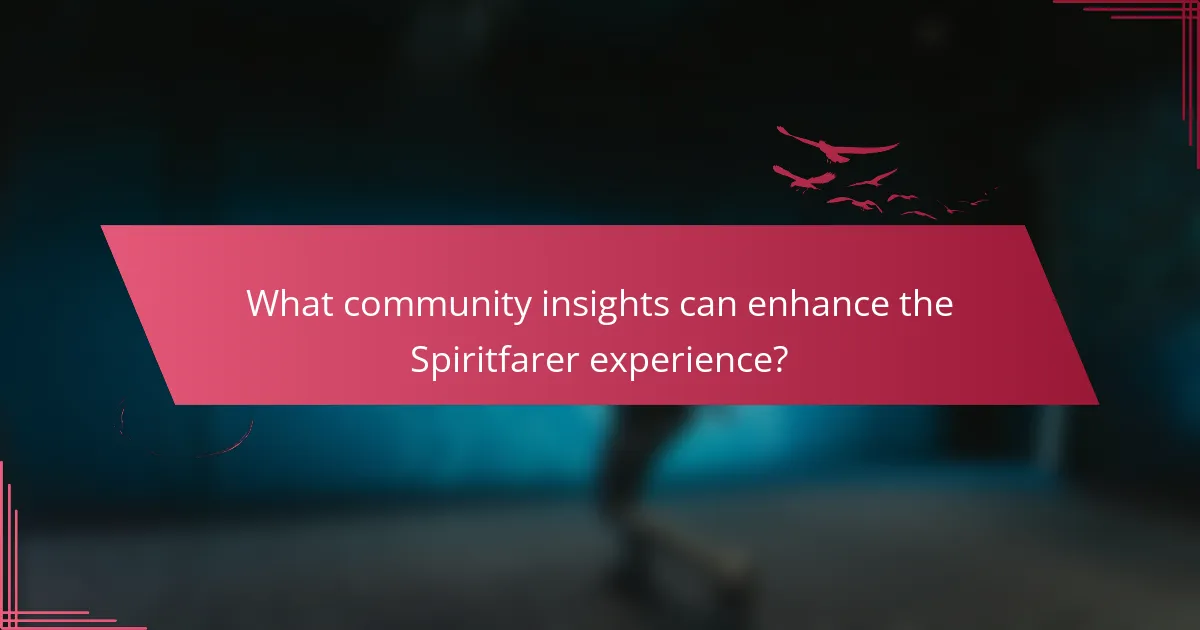
What community insights can enhance the Spiritfarer experience?
Community insights can significantly enhance the Spiritfarer experience by fostering emotional connections and sharing strategies. Engaging with forums and social media can provide players with diverse perspectives on character interactions and resource management techniques.
Players often share unique stories about their journey, highlighting rare attributes like personal connections to characters. This exchange can deepen the emotional impact of the game. Additionally, community-created guides offer valuable tips on optimizing resource management, helping players navigate challenges more effectively.
Participating in discussions can also reveal hidden aspects of the game’s artistic design, enriching the overall experience. By connecting with others, players can discover new ways to appreciate the narrative and gameplay elements that make Spiritfarer a memorable journey.
Which player strategies have emerged from the community?
Players have developed various strategies in Spiritfarer to enhance their emotional journey and resource management. Community insights emphasize efficient resource allocation, prioritizing spirit quests, and optimizing ship upgrades.
Players often recommend focusing on building relationships with spirits to unlock unique abilities and storylines. Additionally, managing resources like food and materials is crucial for progression.
Another strategy involves using the environment effectively, such as fishing and gathering, to ensure a steady supply of resources. Engaging with the game’s artistic design also enhances the overall experience, encouraging players to explore and immerse themselves in the world.
Overall, the community shares a wealth of strategies that revolve around emotional engagement and effective resource management.
What common mistakes should players avoid?
Players should avoid common mistakes like neglecting character relationships, underutilizing resources, and ignoring exploration. Focusing solely on tasks can lead to missed emotional moments. Balancing resource management with personal connections enhances gameplay. Prioritize interactions with spirits to deepen the narrative experience.
How can players share their experiences effectively?
Players can share their experiences effectively by utilizing social media, forums, and in-game features. Engaging with the community enhances emotional connections and resource management strategies. Players can share artwork, stories, and gameplay tips, fostering a collaborative environment. Highlighting unique moments and personal journeys in “Spiritfarer” deepens the collective experience.

